高中英语外研版(2019)必修第三册 Unit3 The world of science Vocabulary&Listeningandspeaking课件(共28张PPT)
文档属性
| 名称 | 高中英语外研版(2019)必修第三册 Unit3 The world of science Vocabulary&Listeningandspeaking课件(共28张PPT) | 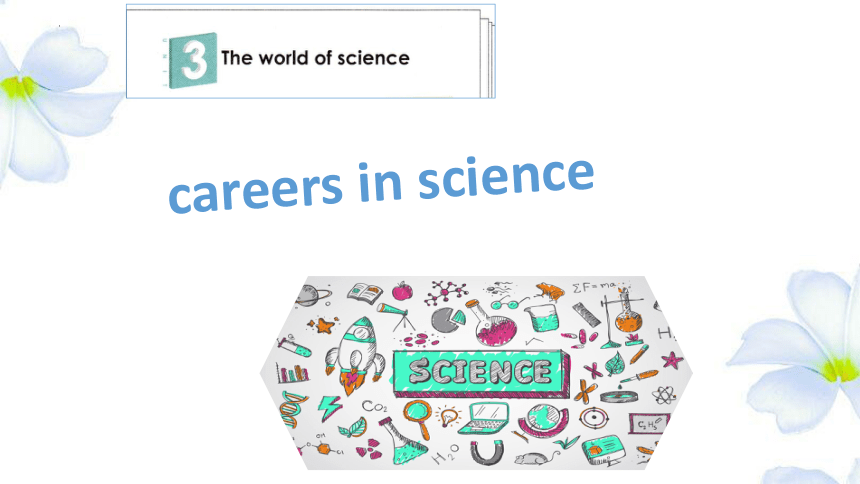 | |
| 格式 | pptx | ||
| 文件大小 | 10.7MB | ||
| 资源类型 | 教案 | ||
| 版本资源 | 外研版(2019) | ||
| 科目 | 英语 | ||
| 更新时间 | 2023-09-13 16:34:35 | ||
图片预览

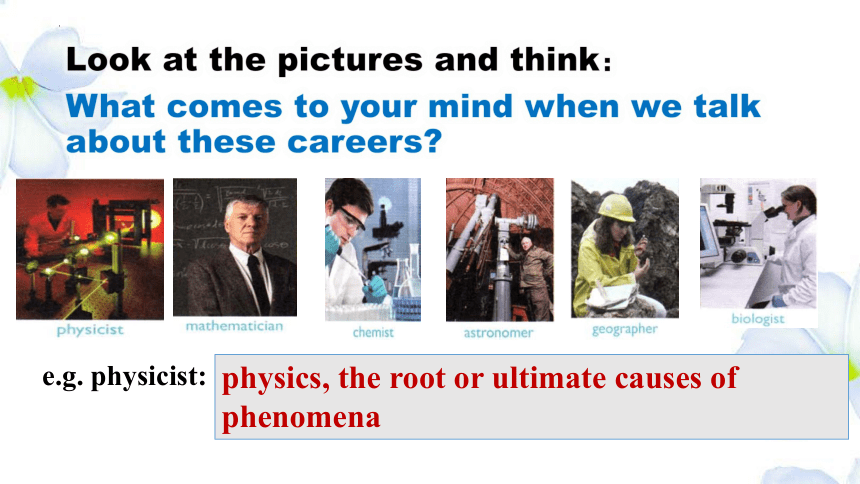
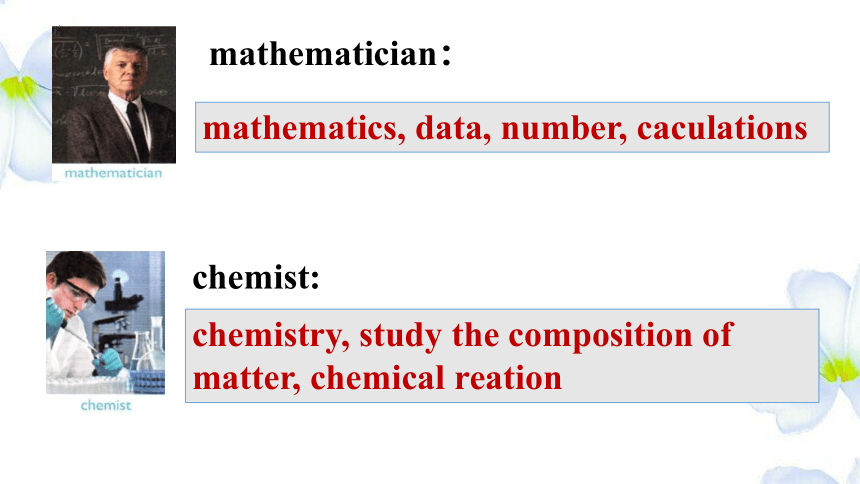


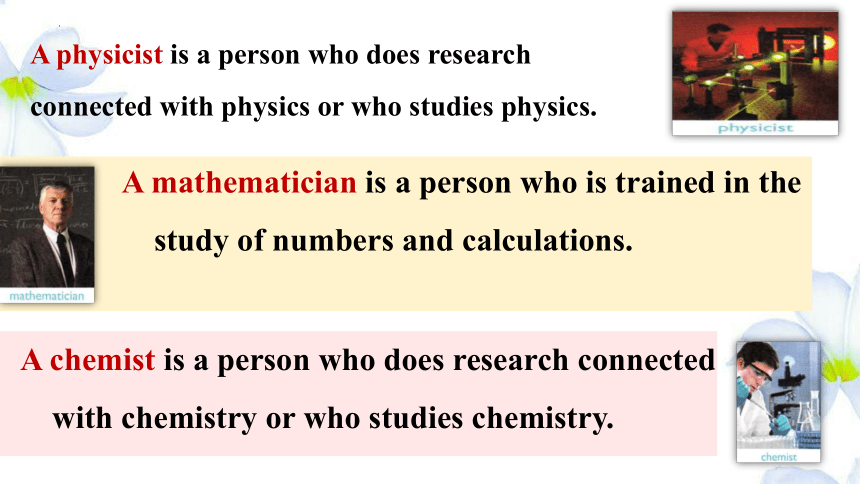
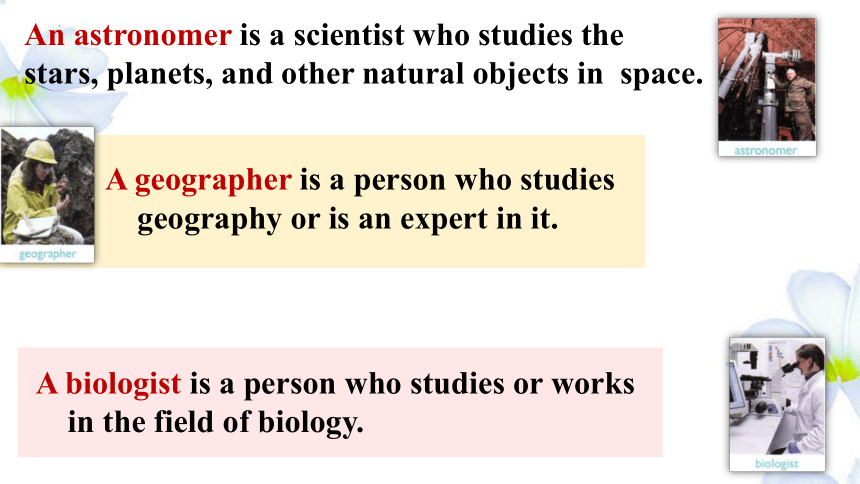
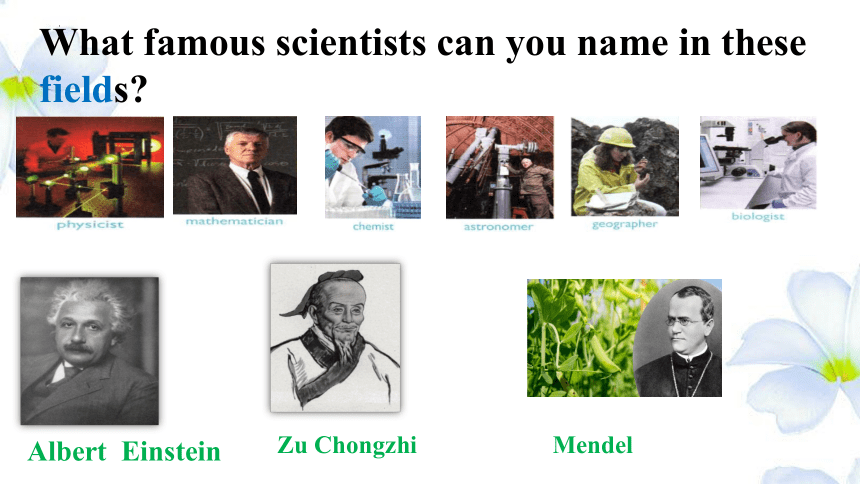
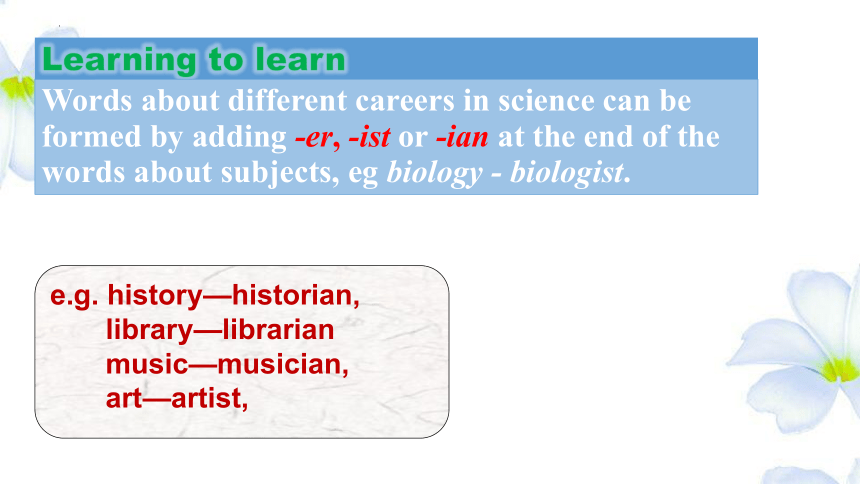
文档简介
(共28张PPT)
careers in science
Look at the pictures and think:
What comes to your mind when we talk about these careers
e.g. physicist:
physics, the root or ultimate causes of phenomena
mathematician:
mathematics, data, number, caculations
chemist:
chemistry, study the composition of matter, chemical reation
astronomer:
astronnomy, stars, planets, natural objects in space
geographer:
geography, field research
biologist:
biology, living organisms, Earth’s natural environment
A physicist is a person who does research
connected with physics or who studies physics.
A mathematician is a person who is trained in the study of numbers and calculations.
A chemist is a person who does research connected with chemistry or who studies chemistry.
An astronomer is a scientist who studies the
stars, planets, and other natural objects in space.
A geographer is a person who studies geography or is an expert in it.
A biologist is a person who studies or works in the field of biology.
What famous scientists can you name in these fields
Albert Einstein
Zu Chongzhi
Mendel
Learning to learn
Words about different careers in science can be formed by adding -er, -ist or -ian at the end of the words about subjects, eg biology - biologist.
e.g. history—historian,
library—librarian
music—musician,
art—artist,
Complete the introductions using ”physicist, mathematician, chemist, astronomer, geographer, biologist”.
Underline the hints that help you complete the introductions.
astronomer
Guo Shoujing (1231-1316) was a famous Chinese 1 _____________ of the Yuan Dynasty. He invented twelve new instruments to study stars and planets. He also developed a calendar which is as accurate as the Gregorian calendar. A mountain on the Moon and a minor planet are named after him.
British 2 ____________ Charles Darwin (1809-1882) is best known for his work On the Origin of Species, in which he explains changes in species due to natural selection. His ideas deeply influence our understand- ing of the relationship between humans and nature.
biologist
Li Daoyuan (ca 466-527) was a famous writer and 3___________ of the Northern Wei Dynasty. He did field research across China and studied more than a thousand rivers and streams, along with the landscape, history and culture of the surrounding areas.
geographer
Marie Curie (1867-1934) was a world-famous 4 ________ and was first awarded the Nobel Prize in 1903 for her extraordinary work on radioactivity. She was also regarded as a brilliant 5 ________, and was again awarded the Nobel Prize in 1911 for the isolation of pure radium.
physicist
chemist
Chen Jingrun (1933-1996) was one of the world’s leading 6 ________________. His work on Chen’s Theorem made an important advance towards proving Goldbach’s Conjecture, the greatest unsolved problem in number theory.
mathematician
Think about other careers in science and discuss what interests you most.
I’m interested in the work of a(n)... because...
listening and speaking
Alzheimer’s disease
How much do you know about Alzheimer’s disease
Read and find:
What problems do Alzheimer’s disease cause
What features do the sufferers have
What are scientists doing for people with the disease
Alzheimer's disease is a brain disorder that causes problems with memory, thinking and behaviour.
The majority of people with Alzheimer's are 65 and above. It is recognised as the most common mental disease among older people, and the number of sufferers is growing. Currently, there's no cure for Alzheimer's, but scientists are researching ways to improve the quality of life for people living with the disease.
Did you know
come up with
keep an eye on
sense V.
alarm n.
step V.
device n.
提出,想出
注意,留意
感知
警报
踩;踏;
装置,仪器
Listen to the conversation and number the pictures in the correct order.
1
once, got lost
2
keep an eye on
3
started by drawing
4
eventually...invented...
5
when his feet touched the floor, the device sensed an increase of pressure, a warning was sent to...
Listen again and complete the notes.
a pair of socks designed for people with Alzheimer’s diseases
a student from New York
His grandfather
A warning
gets out of bed
Talk about how the speakers describe the story behind an invention. Listen again if necessary.
□ Learning to learn
Exclamatory sentences express strong emotions, such as surprise, shock, joy, emphasis强调 and excitement. These are usually formed with what or how, and in written form usually end with an exclamation mark.
He used exclamatory sentences to describe the story. Like “How amazing!” “What a useful invention and caring grandson!”
Pair work
Act out the conversation about the invention of the telephone.
Thank you !
careers in science
Look at the pictures and think:
What comes to your mind when we talk about these careers
e.g. physicist:
physics, the root or ultimate causes of phenomena
mathematician:
mathematics, data, number, caculations
chemist:
chemistry, study the composition of matter, chemical reation
astronomer:
astronnomy, stars, planets, natural objects in space
geographer:
geography, field research
biologist:
biology, living organisms, Earth’s natural environment
A physicist is a person who does research
connected with physics or who studies physics.
A mathematician is a person who is trained in the study of numbers and calculations.
A chemist is a person who does research connected with chemistry or who studies chemistry.
An astronomer is a scientist who studies the
stars, planets, and other natural objects in space.
A geographer is a person who studies geography or is an expert in it.
A biologist is a person who studies or works in the field of biology.
What famous scientists can you name in these fields
Albert Einstein
Zu Chongzhi
Mendel
Learning to learn
Words about different careers in science can be formed by adding -er, -ist or -ian at the end of the words about subjects, eg biology - biologist.
e.g. history—historian,
library—librarian
music—musician,
art—artist,
Complete the introductions using ”physicist, mathematician, chemist, astronomer, geographer, biologist”.
Underline the hints that help you complete the introductions.
astronomer
Guo Shoujing (1231-1316) was a famous Chinese 1 _____________ of the Yuan Dynasty. He invented twelve new instruments to study stars and planets. He also developed a calendar which is as accurate as the Gregorian calendar. A mountain on the Moon and a minor planet are named after him.
British 2 ____________ Charles Darwin (1809-1882) is best known for his work On the Origin of Species, in which he explains changes in species due to natural selection. His ideas deeply influence our understand- ing of the relationship between humans and nature.
biologist
Li Daoyuan (ca 466-527) was a famous writer and 3___________ of the Northern Wei Dynasty. He did field research across China and studied more than a thousand rivers and streams, along with the landscape, history and culture of the surrounding areas.
geographer
Marie Curie (1867-1934) was a world-famous 4 ________ and was first awarded the Nobel Prize in 1903 for her extraordinary work on radioactivity. She was also regarded as a brilliant 5 ________, and was again awarded the Nobel Prize in 1911 for the isolation of pure radium.
physicist
chemist
Chen Jingrun (1933-1996) was one of the world’s leading 6 ________________. His work on Chen’s Theorem made an important advance towards proving Goldbach’s Conjecture, the greatest unsolved problem in number theory.
mathematician
Think about other careers in science and discuss what interests you most.
I’m interested in the work of a(n)... because...
listening and speaking
Alzheimer’s disease
How much do you know about Alzheimer’s disease
Read and find:
What problems do Alzheimer’s disease cause
What features do the sufferers have
What are scientists doing for people with the disease
Alzheimer's disease is a brain disorder that causes problems with memory, thinking and behaviour.
The majority of people with Alzheimer's are 65 and above. It is recognised as the most common mental disease among older people, and the number of sufferers is growing. Currently, there's no cure for Alzheimer's, but scientists are researching ways to improve the quality of life for people living with the disease.
Did you know
come up with
keep an eye on
sense V.
alarm n.
step V.
device n.
提出,想出
注意,留意
感知
警报
踩;踏;
装置,仪器
Listen to the conversation and number the pictures in the correct order.
1
once, got lost
2
keep an eye on
3
started by drawing
4
eventually...invented...
5
when his feet touched the floor, the device sensed an increase of pressure, a warning was sent to...
Listen again and complete the notes.
a pair of socks designed for people with Alzheimer’s diseases
a student from New York
His grandfather
A warning
gets out of bed
Talk about how the speakers describe the story behind an invention. Listen again if necessary.
□ Learning to learn
Exclamatory sentences express strong emotions, such as surprise, shock, joy, emphasis强调 and excitement. These are usually formed with what or how, and in written form usually end with an exclamation mark.
He used exclamatory sentences to describe the story. Like “How amazing!” “What a useful invention and caring grandson!”
Pair work
Act out the conversation about the invention of the telephone.
Thank you !
